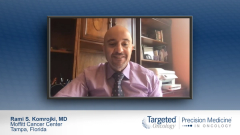
Treatment Paradigm for Myelofibrosis
A review of the treatment armamentarium for patients with myelofibrosis in the context of clinical trial data supporting use of these agents.
Episodes in this series

Transcript:
Rami S. Komrokji, MD: We are excited and fortunate that we finally have more than one JAK2 inhibitor approved for patients, particularly with the constitution symptoms splenomegaly. As it stands now, we have three JAK2 inhibitors, and hopefully in the coming future, fourth will be approved as well. We have ruxolitinib, that has been our back corner for treatment. We have fedratinib and we have pacritinib. Will you highlight the mechanism of action, the clinical trials behind those three JAK2 inhibitors that led to their approval.
Pankit Vachhani, MD: Ruxolitinib was FDA approved in 2011, more than 10 years ago. The approval came through the results primarily of the COMFORT-1 and COMFORT-2 studies. It's a JAK1, JAK2 inhibitor as we spoke. And in COMFORT-1, the patients were randomized against placebo, and it was a double blinded study. In COMFORT-2 the patients were randomized against- from ruxolitinib versus best available therapy. Largely speaking, very comparable clinical trials. The primary endpoint was 35% spleen volume reduction from baseline to 24 weeks in COMFORT-1 or 48 weeks in COMFORT-2. Numerous secondary endpoints including symptom burden reduction in COMFORT-1 for example, survival endpoints as well. And a whole host of other endpoints as well. Now, what's important to note, and we have seen these results and talked about before, but this is remarkable that in COMFORT-1 the spleen volume reduction of 35% more occurred in 41.9% of patients as compared to 0.7% in placebo. For COMFORT-2 it was 28% versus 0%. A clear advantage in the favor of ruxolitinib there. Similarly, the symptom burden reduction occurred far more in patients who were on ruxolitinib compared to the standard arms of placebo or best available therapy. But over the years, as we have followed the patients more with long term follow from both COMFORT-1 and COMFORT-2, what we have realized is that things go way beyond just the spleen volume reduction or symptom burden improvement. That is now overall survival data, it's well published and well documented at this point, which for example has shown that when you pull comfort 1 and comfort 2 patients, the survival for patients who were initially randomized to ruxolitinib was 5.3 years as compared to the control arm patients who had survival of 3.8 years. And that's rather remarkable given that the patients who were in the control arms had deep option and did crossover to ruxolitinib 6 months later. Despite that, a survival advantage in favor of ruxolitinib. The second one is fedratinib. That's a JAK2 inhibitor and a FLT3 inhibitor. It was studied in the Jakarta of one phase 3 study where patients were randomized to fedratinib 500 mg daily or 400 mg daily or Placebo and as a note that the dose that was FDA approved which we can use now is fedratinib 400 mg daily. When you look at the results of that cohort, the spleen volume reduction rate was 36%, and similarly the symptom burden reduction of 50% or more was also 36%. In terms of Jakarta 2, which is the phase 2 single arm open label study, multicenter study in patients who had previously been on ruxolitinib, the spleen volume reduction rates and symptom burden reduction rates were around 30% roughly speaking, suggesting that it is an option for use even in patients who have previous been on ruxolitinib. Now it is a FLT3 inhibitor as well and GI adverse events are seen in patients who go on fedratinib. Pacritinib, which is the third FDA approved drug in Myelofibrosis as a JAK inhibitor, that is a JAK2 and IRAK1 inhibitor. The drug was FDA approved on February 28th, 2022 mainly based on the results of Persist-2 study, but it has been studied previously in Persist-1 and also the dose finding part 2 or 3 study not to mention the ongoing Pacifica study as well. This Persist-2 study randomized patients to pacritinib 400 mg daily. That's not the dose that's FDA approved or 200 mg twice daily, just the FDA approved dose versus best available therapy on. And whether you take the intent to treat population or focus more so on the population that has platelets less than 50,000, i.e. that site which is where the drug is actually approved in 2022, the spleen volume reduction as well as the symptom burden reduction favored pacritinib as opposed to past available therapy. For example, for spleen volume, the rate was almost 30% whereas in best available therapy on it was 3%. That's the third JAK inhibitor that we have available right now. The Pacifica study, which is ongoing, it is a study for patients with platelet counts of 50,000 or less and JAK inhibitor naive patients. The results are expected in a few years from now. Very recently though we have seen that pacritinib also happens to have inhibitory activity against ACVR1. ACVR1 inhibition is thought to be the primary or one of the main mechanisms through which momelotinib maybe has hemoglobin improvements or hemoglobin stabilization data. Now we are seeing data in favor of pacritinib being a very potent, only more potent than the other JAK inhibitors. Pacritinib has a ACVR1 and maybe there is partly the reason if not all as to why some patients at least in Persist-2 saw hemoglobin improvements of 1 gram per deciliter or 2 grams per deciliter or even transfusion independence achievement at various time points or in rolling phases. This space will be very interesting to see in how cytopenias play out anemia will be very interesting to see. The fourth point that I do want to mention is the concept of early treatment. What does early treatment mean? This is a topic which can mean different things to different people. Early treatment could mean that you just diagnosed a patient with high risk disease or it could mean someone with low clinical risk disease like what Dr Komrokji was mentioning. Lower risk MF by one after a stratification schema or it could mean a disease that's in the pre-fibrotic phase, so not yet MF fully or something a scenario where the MF is there but has a low disease burden. We call early disease by different names as we just spoke about, but maybe treating early has an advantage. We have seen data for ruxolitinib whereby treating earlier rather than later, meaning earlier in the diagnosis process right after diagnosis may have better outcomes. We have seen this data. Patients with lesser splenomegaly behave and have better outcomes as well and down the line it may even allow for potentially halting the clonal evolution, maybe allow us for adding additional therapeutics and stop cytopenia’s from development and truly lead to disease modification down the line.
Transcript edited for clarity.











































